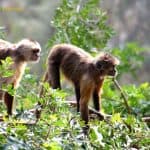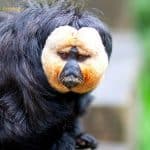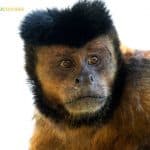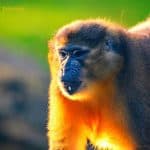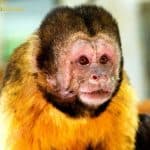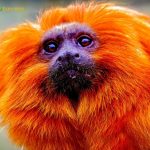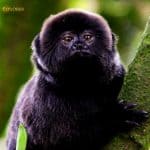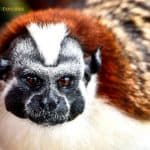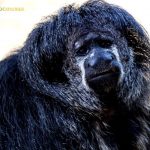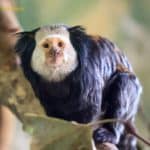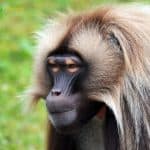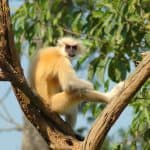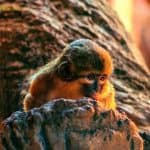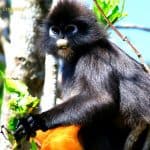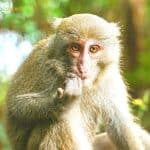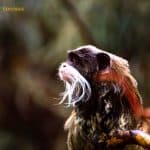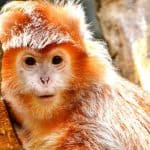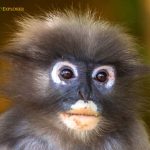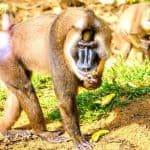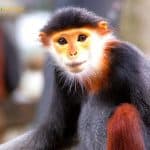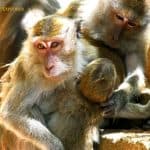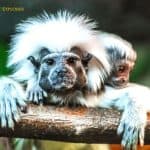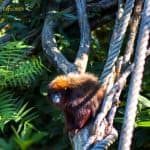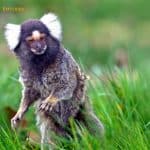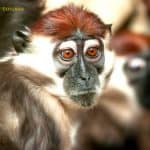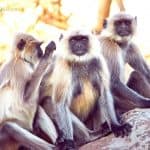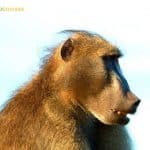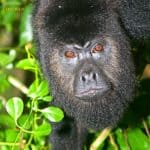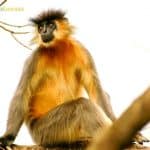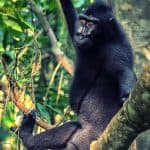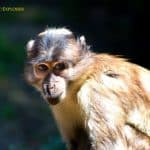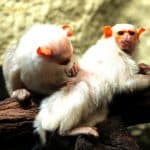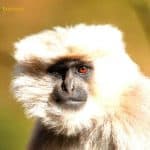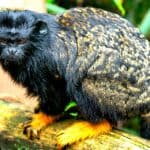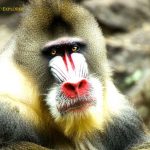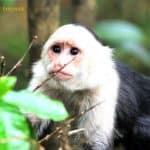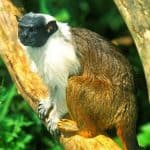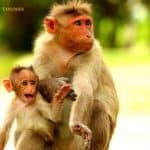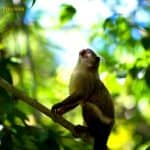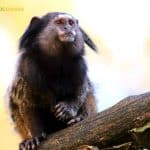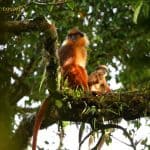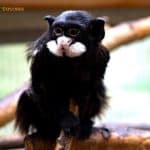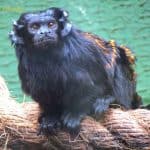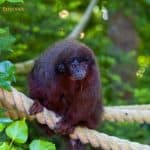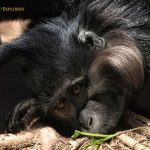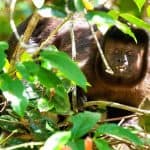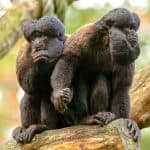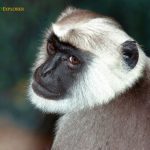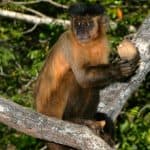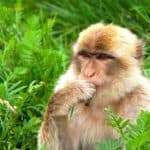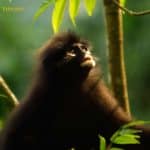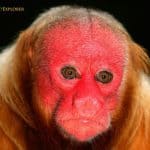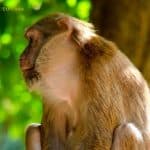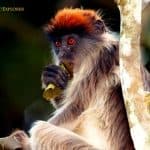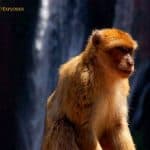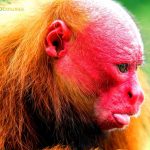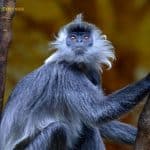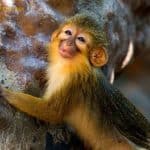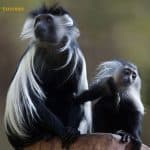Monkey - search results
If you're not happy with the results, please do another search
Guianan Weeper Capuchin
The wedge-capped capuchin (Cebus olivaceus), also known as Guianan weeper capuchin, is a capuchin monkey native to South America. Wedge-capped capuchins get their name from a black triangle of dark fur centered on their forehead.
Guianan Saki
The white-faced saki (Pithecia pithecia), also known as the golden-faced saki, Guianan saki, and Guyana saki, is a New World saki monkey species. Typically, they have a lifespan of around 14 years in the wild and have lived up to 36 years in captivity.
Guianan Brown Capuchin
The tufted capuchin (Sapajus apella), also called the pin monkey, Guianan brown capuchin, or black-headed capuchin is a New World monkey native to South America and the Caribbean islands of Margarita and Trinidad.
Golden-Headed Lion Tamarin
The golden-headed lion tamarin (Leontopithecus chrysomelas), also known as the golden-headed tamarin, is a lion tamarin native to Brazil. It is only found in fragments of lowland and premontane forests in the state of Bahia and is therefore considered an endangered species.
Golden-Bellied Mangabey
The golden-bellied mangabey (Cercocebus chrysogaster) is a gregarious Old-World monkey found in humid, swampy forests south of the Congo River. Golden-bellied mangabeys are a migratory and social species, moving in groups of 8 to 30 members.
Golden-Bellied Capuchin
The golden-bellied capuchin (Sapajus xanthosternos), also called the buff-headed or yellow-breasted capuchin is a New World monkey species. They spend much time grooming one another for socialization, with the alpha species receiving the most attention.
Golden Lion Tamarin
The golden lion tamarin (Leontopithecus rosalia), also called the golden tamarin, is a small New World primate in the Callitrichidae family. The golden lion tamarin derives its name from its vivid reddish-orange coat and extra-long hair around its face and ears, giving it a distinctive mane.
Goeldi’s Marmoset
Goeldi marmoset or Goeldi monkey is a small South American New-World monkey living in the upper Amazon basin region of Brazil, Bolivia, Ecuador, Colombia, and Peru. Goeldi marmosets generally stay less than 5 meters from the forest floor, moving to higher elevations for fruit.
Geoffroy’s Tamarin
Geoffroy's tamarin, also called the Panamanian tamarin, red-crested tamarin, or rufous-naped marmoset tamarin, is a tamarin, a small monkey found in Colombia and Panama. In what may seem like a role reversal in many monkey species, Geoffroy's tamarins are led by the oldest female in a group.
Geoffroy’s Monk Saki
Geoffroy's monk saki, also called monk saki, is a species of saki monkey, a New-World primate native to South America. A monk saki is one of seven species of New-World arboreal monkeys with a bushy, feathery tail.
White-Headed Marmoset
The Geoffroy's marmoset, also called Geoffrey's marmoset, white-headed marmoset, or tufted-ear marmoset is a marmoset native to the forests of eastern Brazil, where it is native to Minas Gerais, Espírito Santo, and Bahia. Geoffroy's marmosets are said to follow swarms of army ants to catch insects expelled by the ants.
Gelada
The gelada often called the gelada baboon, or the bleeding-heart monkey, is an Old-World monkey found only in the Ethiopian highlands. Geladas aren't territorial, and it is not unusual to find congregations of separate groups foraging together when conditions are favorable.
Gee’s Golden Langur
Gee's golden langur, also known simply as the golden langur, is an Old-World primate found in a small area of western Assam, India, and in the nearby foothills of the Black Mountains of Bhutan. Gee's golden langur was officially discovered in 1953 by Edward Pritchard Gee, an amateur naturalist and tea planter in Assam, India.
Gabon Talapoin
The Gabon talapoin, also called the northern talapoin, is a small species of African primate endemic to riverine habitats in Gabon, Equatorial Guinea, Cameroon, the far western Democratic Republic of the Congo, and the western Republic of the Congo.
François’ Langur
The François langur, also called the white side-burned black langur, François leaf monkey, or Tonkin leaf monkey is a species of Lutung and the type species of its species group. The François langur is among the least studied langur species.
Formosan Rock Macaque
The Formosan rock macaque also called the Taiwanese macaque, or Formosan rock monkey, is a macaque native to the island of Taiwan. Aside from humans, Formosan rock macaques are the only native primates living in Taiwan.
Emperor Tamarin
The Emperor Tamarin is a species of tamarin named for its resemblance to the German Kaiser Wilhelm II. It lives in the states of Acre and Amazonas, western Brazil, and the southwestern Amazon basin.
East Javan Langur
The East Javan langur, also called the Javan lutung, Javan langur, or ebony langur is an Old-World primate in the subfamily Colobinae. As with all langurs, the East Javan langur is a social animal, living in groups of about 7 individuals, with 1 or 2 adult males in the group.
Dusky Langur
Dusky langurs also known as spectacled langurs, spectacled leaf monkeys, and dusky leaf monkeys, are primarily found in the Malay Peninsula in Asia. White rings surrounding the deep, dark eyes give the species its alternative name, the spectacled monkey or spectacled langur, for a "bespectacled" look.
Drill
The Drill is a primate in the Cercopithecidae family (Old-World monkeys), related to baboons and even more closely to mandrills. Like mandrills, drills are highly social animals that live in groups of around 20 individuals with multiple males and females, with one male dominating reproductive decisions.
Red-Shanked Douc Langur
The red-shanked douc langur is an Old-World monkey species that is one of the most colorful primates. Red-shanked douc langurs are genetically similar to gray-shanked douc langurs; however, they are considered a different species due to their different biological characteristics.
Crab-Eating Macaque
The crab-eating macaque also called the long-tailed macaque and known in laboratories as the cynomolgus monkey, is a primate monkey endemic to Southeast Asia. Crab-eating macaque macaques live in multi-male groups comprising around 30 members.
Cotton-Top Tamarin
The cotton-top tamarin is another small New-World primate found at the edge of tropical and secondary forests in northwestern Colombia. The common names "cotton-headed tamarin" and "cotton-top tamarin" are derived from the white hairs that spread across the head and flow down the neck.
Coppery Titi
The coppery titi, or the red titi, is a species of titi, a type of New-World monkey native to South America. Coppery titi monkeys have dense fur that covers most of the body except for the face.
Common Marmoset
The common marmoset, also known as white-tufted-ear marmoset or white-tufted marmoset, is a type of New World monkey. As they have adapted to life at the forest edge of southeastern Brazil, common marmosets have also learned to take advantage of the region's plantations.
Collared Mangabey
The collared mangabey, also called the white-collared mangabey or red-capped mangabey, is an Old-World monkey endemic to the Atlantic coast of central and west Africa. Its distinctive chestnut-red cap gives the species the name red-capped mangabey, and its white collar gives it the names white-collared and collared mangabey.
Kashmir Gray Langur
The Kashmir gray langur is an Old-World monkey, one of the species of langurs. The Kashmiri gray langur derives its scientific name, Semnopithecus ajax, from a character in the ancient Greek poem - The Iliad - set during the Trojan War.
Chacma Baboon
Like all other baboons, the Chacma baboon, the Cape baboon, belongs to the Old-World monkey family. Chacma baboons have a habit of flipping over rocks in search of food. So, it's pretty easy to spot where a group of Chacmas once foraged.
Yucatan Black Howler
The Yucatan black howler, also called the Guatemalan black howler or Central American black howler, is a New-World monkey native to Central America. The Yucatan black howler monkey is the largest species of howler monkey and among the largest monkeys in the New-World.
Capped Langur
The capped langur is a type of monkey in the Cercopithecidae family. These langurs can vary in appearance. This Asian primate gets its name from the thick hairs on the top of the head, typically gray or black.
Crested Black Macaque
The Crested Black Macaque, also called the Sulawesi Crested Macaque or Celebes Crested Macaque is an Old World monkey native to the Tangkoko Game Reserve in the extreme northeast of the Indonesian island of Celebes (Sulawesi) and neighboring islets.
Sooty Mangabey
The sooty mangabey, also called the white-collared or white-crowned mangabey is a predominantly terrestrial Old-World monkey. Sooty mangabeys remember the location of the fallen fruit and can tell whether or not a tree is bearing fruit.
Silvery Marmoset
The Silvery marmoset (Mico argentatus) is a New-World monkey living in the eastern Amazon rainforest of Brazil. True to its name, the silvery marmoset's body is a striking silver-grey color. Silvery marmosets are primarily arboreal species and can spend their entire lives in trees without descending to the ground.
Nepal Gray Langur
The Nepal gray langur (Semnopithecus schistaceus) is a gray langur native to the Himalayas of Nepal, extreme southwestern Tibet, northern Pakistan, northern India, Bhutan, and possibly Afghanistan. The Nepal gray langur is both terrestrial and arboreal.
Midas Tamarin
The Midas tamarin (Saguinus midas), also called the red-handed tamarin or golden-handed tamarin is a New-World monkey in the Callitrichidae family. Midas tamarin is also known as golden tamarin or red-handed tamarin. This attests to the remarkably vivid colors of the feet and hands.
Mandrill
The mandrill (Mandrillus sphinx) is a primate of the Old-World monkey family (Cercopithecidae). It is among the two species in the Mandrillus genus and drill. Groups of mandrills can vary from a few individuals to 50 individuals.
White-Throated Capuchin
White-throated capuchins, also called the white-headed capuchins, Colombian white-throated capuchins, and white-faced capuchins, are New World monkeys native to the tropical rainforests of western Colombia, Ecuador, and Panama.
Brazilian Bare-Faced Tamarin
The pied tamarin, also known as the pied bare-faced tamarin or Brazilian bare-faced tamarin, has one of the smallest home ranges of any primate in the world, located in and around the port city of Manaus.
Bonnet Macaque
The Bonnet Macaque, also called Zati, is a species of macaque native to southern India. Bonnet macaques get their common name from a unique feature: a hood-like tuft of hair that extends from the top of their head, much like a tuft of dry grass. Their marble-round eyes look out into the world with a very expressive forehead.
Black-Tailed Marmoset
The black-tailed marmoset is a New-World monkey species native to central South America. It is distributed from south-central Amazonia in Brazil to the Chaco far north of Paraguay. Black-tailed marmosets are arboreal and diurnal, using their claws for tree climbing.
Black-Tufted Marmoset
The black-tufted marmoset, also called the Black-pencilled marmosets or Mico-estrela in Portuguese is a type of New-World monkey. They live mainly in the neotropical gallery forests of the central Brazilian plateau.
Black-Crested Sumatran Langur
The black-crested Sumatran langur (Presbytis melalophos), also called the Mitred leaf monkey, is a primate species in the Cercopithecidae family. The black-crested Sumatran langur, Raffles' banded langur, Sarawak surili, and black-and-white langur were formerly considered subspecies of Presbytis melalophos.
Moustached Tamarin
Moustached tamarins, also known as black-chested moustached tamarins and Spyx's moustached tamarins, are native to Peru and Brazil. These monkeys are found in all strata of the lowland Amazon rainforest. The moustached tamarin gets its name from the lack of coloration in the facial hair around the mouth, which resembles a mustache.
Black Tamarin
Also known as western black-handed tamarind, the black tamarind is a species of tamarin native to Brazil. Black tamarind uses primary and secondary forests during foraging, primarily attaching itself to the canopy and spending little time on the ground.
Black Lion Tamarin
The black lion tamarin, also called the golden-rumped lion tamarin, is a lion tamarin native to the Brazilian state of Sao Paulo, almost exclusively in Morro do Diabo State Park. Its limited geographic range makes it the rarest of the New-World monkeys.
Black-crested mangabey
Black-crested mangabeys, also known as black mangabeys, are endemic to central Africa, occupying the Democratic Republic of the Congo, south of the Congo River (formerly known as the Zaire River), and likely extinct in Angola. They are mainly found in primary and secondary tropical forests, gallery forests, and swamps. Locals nicknamed these primates "baboon mangabeys" due to their resemblance to the baboon species.
Black Capuchin
The black capuchin, also called the black-horned capuchin, is a capuchin monkey native to the Atlantic rainforest of southeastern Brazil and extreme northeastern Argentina. The black capuchin was originally called Cebus nigritus or Cebus apella nigritus. Although this has changed, many sources still name the black capuchin as part of the Cebus genus.
Black Bearded Saki
The black-bearded saki is a species of bearded saki, a species of New World monkey, one of the five remaining monkeys of its kind. Another striking feature is its signature beards. This species prefers primary rainforest, where lush tree canopies provide a relatively safe area out of sight and out of reach of several predators.
Bengal Sacred Langur
The Bengal sacred langur, also known as Hanuman's langur and the northern plains gray langur, is a primate species in the Cercopithecidae family. The Bengal sacred langurs are often referred to as "Hanuman's langurs", named after Lord Hanuman - the Hindu god.
Bearded Capuchin
The bearded capuchin, also called the black-striped capuchin, is a New World monkey in the Cebidae family. They are found in central and northern Brazil. Until recently, the bearded capuchins were considered a subspecies of Tufted Capuchins.
Barbary Macaque
The Barbary macaque, also called the Magot macaque, is a macaque endemic to the Atlas Mountains in Morocco and Algeria and a small introduced population in Gibraltar. Before the Ice Age, they inhabited the Mediterranean coasts and most of Europe, as far away as the British Isles and Germany.
Banded Langur
The Banded langur, also known as the Raffles' banded langur or banded leaf monkey, is a primate species in the Cercopithecidae family. Like other Colobin monkeys, whose young typically have lighter-colored fur than adults, Banded langur infants have white or tan fur until it darkens around 6 months.
Bald Uakari
The obscure Bald Uakari (Cacajao Calvus) is an acrobatic Amazonian monkey with a flaming red face uniquely adapted to periodically flooded forests. Surprising insights on its taxonomy, specialized seed-based diet, unusual social life, habitat flexibility, and urgent need to conserve diminishing flooded forest habitat across the Amazon Basin.
Assam Macaque
The Assam macaque, also known as Assamese macaque, is a macaque of the Old-World monkey family endemic to South and Southeast Asia. Assam is another state in India. Eating everything from fruits to 55 types of flowers, leaves, seeds, and bark, these macaque monkeys adapt their diet to suit their habitat.
Ashy Red Colobus
The Ashy-red Colobus or Ugandan red Colobus is an endangered species of red Colobus endemic to Eastern Africa. Like other colobus monkeys, Ashy Red has small thumbs that allow it to comfortably grip branches and swing nimbly through the canopy. In 2001, the ashy-red Colobus was recognized as a separate species.
Arunachal Macaque
The Arunachal macaque is a comparatively sizeable brown primate with a relatively short tail. Arunachal macaques were first classified into Cercopithecidae's taxonomy in 2005 by primatologists Madhusudan and Mishra.
Aracá Uakari
The Aracá uakari, also called the Ayres black uakari, is a newly described monkey species endemic to the northwestern Brazilian Amazon. The species was found by Jean-Philippe Boubli of the University of Auckland after following local Yanomamo Indians on their hunts along the Aracá River, a northern tributary of the Negro River.
Annamese Silvered Langur
The Annamese langur is another Old-World monkey in the subfamily Colobinae. Annamese langurs are covered in thick, gray fur. They have dark faces, and the space around the eyes is pale and forms a ring, often in the flesh. Trachypithecus margarita is a monotypic species as it has no subspecies.
Angolan Talapoin
Also known as the Southern talapoin, Angolan talapoin is a primate species in the Cercopithecidae family. Tail color varies from grayish-black to brownish-black above and is yellow or yellowish-gray below. The Angolan talapoin monkeys are among the smallest species of Old-World monkeys.
Angolan Colobus
The Angolan Colobus is a conspicuously-patterned monkey with a very long tail that helps it maintain its balance as it moves quickly through the trees. Although the species is named after Angola, it's rare in this country.


